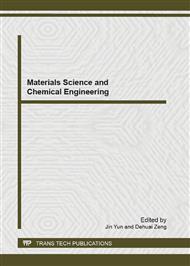[1]
K. Honda, A. Fujishima. "Electrochemical Photolysis of Water at a Semicondutor Electrode", Nature, 238 (1972) 37.
Google Scholar
[2]
Bamwenda GR, Tsubota S, Nakamura T, Haruta M. "Photoassisted hydrogen production from a water–ethanol solution: a comparison of activities of Au-TiO2 and Pt-TiO2." J Photochem Photobiol A Chem 1995;89:177–89.
DOI: 10.1016/1010-6030(95)04039-i
Google Scholar
[3]
Sreethawong T, Yoshikawa S. "Enhanced photocatalytic hydrogen evolution over Pt supported on mesoporous TiO2 prepared by single-step sol-gel process with surfactant template." Int J Hydrogen Energy 2006;31:786–96.
DOI: 10.1016/j.ijhydene.2005.06.015
Google Scholar
[4]
Choi WY, Termin A, Hoffmann MR. "The role of metal ion dopants in quantum-sized TiO2: correlation between photoreactivity and charge carrier recombination dynamics." J Phys Chem 1994;98:13669–79.
DOI: 10.1021/j100102a038
Google Scholar
[5]
Wilke K, Breuer HD. "The influence of transition metal doping on the physical and photocatalytic properties of titania." J Photochem Photobiol A Chem 1999;121:49–53.
DOI: 10.1016/s1010-6030(98)00452-3
Google Scholar
[6]
Xu AW, Gao Y, Liu HQ. The preparation, characterization, and their photocatalytic activities of rare-earth-doped TiO2 nanoparticles. J Catal 2002;207:151–7.
DOI: 10.1006/jcat.2002.3539
Google Scholar
[7]
A.Galin´ska,J.Walendziewski, "Photocatalytic watersplitting over Pt–TiO2in the presence of sacrificial reagents", Energy & Fuels, 19, (2005) 1143–1147.
DOI: 10.1021/ef0400619
Google Scholar
[8]
Sayama K, Arakawa H. "Effect of carbonate salt addition on the photocatalytic decomposition of liquid water over Pt-TiO2 catalyst." J Chem Soc Faraday Trans 1997;93:1647–54.
DOI: 10.1039/a607662i
Google Scholar
[9]
Chen Xiaobo, Mao Samuel S. Titanium Dioxide Nanotmaterials: Synthesis, Properties, Modifications, and Applications. Chem. Rev. 2007, 107, 2891-2959
DOI: 10.1021/cr0500535
Google Scholar
[10]
Kusuga, et al. Formation of Titanium Oxide Nanotube. Langmuir 1998, 14, 3160-3163
Google Scholar
[11]
Palomino, GT, Fisicaro P, Bordiga S, Secchina A. Oxidation States of Copper Ions in ZSM-5 Zeolites. A Multitecnique Investigation. J, Phys. Chem. B 2000, 104, 4064-4073
DOI: 10.1021/jp993893u
Google Scholar


